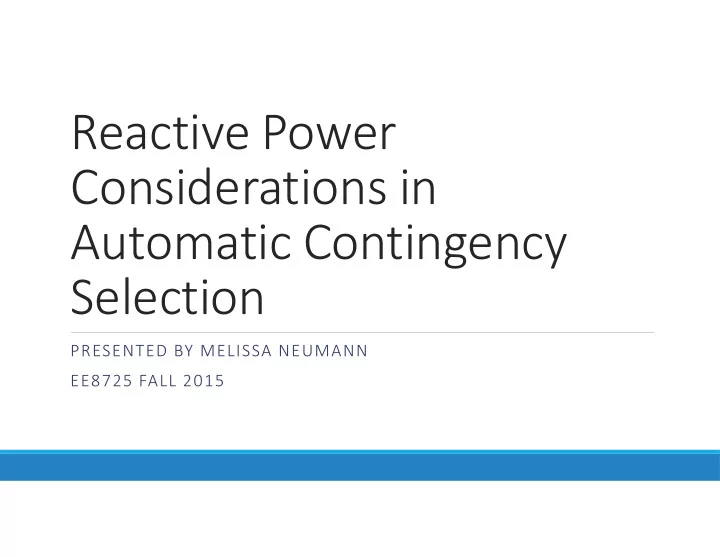

Reactive Power Considerations in Automatic Contingency Selection PRESENTED BY MELISSA NEUMANN EE8725 FALL 2015
Outline What is Contingency Analysis? Computing Technology in the 1980s Fast Decoupled Load Flow Motivation to Create New Contingency Method Fast Decoupled Contingency Method Performance Indices Real Power Voltage-Reactive Power Contingency Ranking Contingency Selection Computational Efficiency for the Method References MELISSA NEUMANN EE8725 FALL 2015 2
What is Contingency Analysis? Analysis to ensure reliable operation of the power grid in the event of failures Analysis is typically done n-1 or n-2 Failures might include Line loss Generator loss Equipment loss A list of failures the could potentially have a large system impact are identified The failure list is the contingency list MELISSA NEUMANN EE8725 FALL 2015 3
Computing Technology in the 1980s Cyber 170 Series Computers 262k 60 bit words memory Operate at one million floating point operations a second Computational efficiency very important Computers cost over a million dollars MELISSA NEUMANN EE8725 FALL 2015 4
Fast Decoupled Load Flow (FDLF) By making reasonable engineering assumptions, amount of calculation were reduced Able to eliminate two parts of the Jacobian Δ� Δ� = � � 0 Δ� 0 � � Δ� MELISSA NEUMANN EE8725 FALL 2015 5
Fast Decoupled Load Flow (cont.) The impedance of transmission lines is mostly reactive Conductances are significantly less than susceptance (G ij <<B ij ) Under normal steady state operation, the angular difference among bus voltages are small (ϴ i - ϴ j ≈ 0 ) Injected reactive power at a bus is much less than reactive power consumed by the connecting elements when shorted to ground 2 ) (Q i <<B ii V i Using this information we are able to eliminate J 2 of the Jacobian MELISSA NEUMANN EE8725 FALL 2015 6
Fast Decoupled Load Flow (cont.) Similarly we are able to eliminate J 3 of the Jacobian MELISSA NEUMANN EE8725 FALL 2015 7
Motivation to Create New Contingency Method Need to study contingencies on the power system Testing all contingencies takes a long time This paper describes a method to select the important contingencies to study Other methods focus on line loading and overlook contingencies that affect voltage Need to study voltage to prevent voltage limit violation MELISSA NEUMANN EE8725 FALL 2015 8
Fast Decoupled Contingency Method Extension of a DC Flow method Uses a performance index which includes voltage limit violations and reactive power deviations Normally a Fast Decoupled power flow converges to a solution in 3-4 iterations The solution from the first iteration is considered within “engineering” tolerance and from there we calculate a performance index for every outage Outages ranked based on index MELISSA NEUMANN EE8725 FALL 2015 9
Performance Indices: Real Power Index to measure line MW overloads. � � ℓ �� �� = ∑ � � � ��� � ℓ Where ◦ � � = Real power weighting factor ◦ � ℓ = MW flow in line ℓ ��� = ◦ � ℓ MW capacity of limit ◦ α = Set of overloaded lines MELISSA NEUMANN EE8725 FALL 2015 10
Performance Indices: Voltage – Reactive Power Index to measure if either the voltage or reactive power is outside of a specified range. ��� ��� � � �� � � �� � � �� �� = ∑ � + ∑ � � � � � ��� ��� � � � � Where ◦ � � = Voltage magnitude at bus i ��� = ◦ � Voltage magnitude limit at bus i � ◦ � � = Voltage weighting factor ◦ � � = Reactive power injection at bus i ��� = ◦ � � Reactive power limit at bus i ◦ � � = Reactive power weighting factor ◦ β = Set of buses at which the voltage magnitude is either below a min or above a max ◦ γ = Set of buses at which the reactive power is either below a min or above a max MELISSA NEUMANN EE8725 FALL 2015 11
Contingency Ranking 1. Iteration one calculates the performance indices for every outage 2. Outage ranking created using real power index 3. Separate outage ranking created using voltage – reactive index MELISSA NEUMANN EE8725 FALL 2015 12
Contingency Selection – Stopping Criteria Ranking of contingencies in order of severity Starting with the most severe, run a full AC analysis Run AC analysis for the next most server case Stop when Desired number of contingencies have been studied No overloads or limit violation over the last N amount of cases analyzed MELISSA NEUMANN EE8725 FALL 2015 13
Computational Efficiency of the Method Problem required solving many power flows, one for each contingency Table IV from the paper shows the CP time saved To reduce the number of iterations required for using the ranking method each power flow solution, the power flow for each Ranking Full contingency used the results from the first iteration as a base case No need to create a new admittance matrix for Average CP .3626 .6732 each contingency Time per outage case (seconds) MELISSA NEUMANN EE8725 FALL 2015 14
References [1] Albuyeh, F.; Bose, A.; Heath, B., "Reactive Power Considerations in Automatic Contingency Selection," in Power Apparatus and Systems, IEEE Transactions on , vol.PAS-101, no.1, pp.107- 112, Jan. 1982 [2] Das, D. (n.d.). Fast-decoupled load-flow (FDLF) techniq. Retrieved October 11, 2015. http://nptel.ac.in/courses/108107028/module2/lecture9/lecture9.pdf MELISSA NEUMANN EE8725 FALL 2015 15
Questions? MELISSA NEUMANN EE8725 FALL 2015 16
Recommend
More recommend